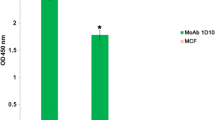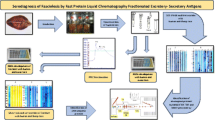Abstract
Two solubleToxoplasma gondii antigen preparations were compared using the immunoblotting technique. The first preparation, which is commonly employed in ELISA tests, corresponds to a lytic extract of the parasite. The second known as exo-antigen, has yielded good results in cell immunity research and is obtained fromToxoplasma gondii culture supernatants. In both preparations, components exhibiting same molecular weight of 57–52 (doublet), 43, 38, 35, 30 and 20 kDa were revealed. In addition, two major 27- and 78-kDa components were detected in exo-antigens. The 30 kDa protein was intensely recognised by all sera, confirming the advantage of its use as an antigen in serological reactions. Exo-antigens could be employed as a soluble antigenic solution because they are easy to obtain, they display good antigenicity and their antigenic composition has been defined. Moreover their preparation does not require mouse inoculation. An evaluation of the enzyme-linked immunosorbent assays (ELISAs) involving these antigens has yet to be performed.
Similar content being viewed by others
References
Ambroise-Thomas P, Garin JP, Rigaud P (1966) Amélioration de la technique d'immunofluorescence par l'emploi de contre-colorants. Presse Med 74:2215–2216
Ambroise-Thomas P, Cagnard MY, Roumiantzeff M, Colombet G (1982) Détection de l'immunité toxoplasmique par intradermoréactions à l'aide d'exo-antigènes deToxoplasma gondii. Lyon Med 248:79–83
Araujo FG, Handman E, Remington JS (1980) Use of monoclonal antibodies to detect antigens ofToxoplasma gondii in serum and other body fluids. Infect Immun 30:12–16
Bessières MH, Roques C, Séguéla JP (1986) Immunochemical analysis of bradyzoite and tachyzoite ofToxoplasma gondii exoantigens (abstract). In: Howell MJ (ed) Parasitology-quo vadis? Proceedings of the 6th International Congress or Parasitology, Brisbane, Australian Academy of Science, Canberra, p 91
Bradford MM (1976) A rapid and sensitive method for the quantitation of microgram quantities of protein utilizing the principle of protein-dye binding. Anal Biochem 72:248–254
Chumpitazi B, Ambroise-Thomas P, Cagnard M, Autheman JM (1987) Tsolation and characterization ofToxoplasma exo-antigens from in vitro culture in MRC 5 and VeRo cells. Int J Parasitol 17:829–833
Couvreur C, Sadak A, Fortier B, Dubremetz JF (1988) Surface antigens ofToxoplasma gondii. Parasitology 97:1–10
Darcy F, Deslee D, Santoro F, Charif H, Auriault C, Decoster A, Duquesne V, Capron A (1988) Induction of a protective antibody-dependent response against toxoplasmosis by in vitro excreted/secreted antigens from tachyzoites ofToxoplasma gondii. Parasite Immunol 10:553–567
Decoster A, Darcy F, Capron A (1988) Recognition ofToxoplasma gondii excreted and secreted antigens by human sera from acquired and congenital toxoplasmosis: identification of markers of acute and chronic infection. Clin Exp Immunol 73:376–382
Derouin F, Mazeron MC, Garin YJF (1987) Comparative study of tissue culture and mouse inoculation methods for demonstration ofToxoplasma gondii. J Clin Microbiol 25:1597–1600
Desgeorges PT, Billiault X, Ambroise-Thomas P, Bouttaz M (1980) Mise en évidence et cinétique d'apparition d'exo antigènes produits parToxoplasma gondii en culture in vitro. Lyon Med 243:737–740
Dubremetz JF, Dissous C, Ferreira A (1982)Toxoplasma gondii: liberation d'une protéine de 25 kd associée à l'invasion de la cellule hôte. J Protozool 29:303
Hassl A, Auer H, Hermentin K, Picher O, Aspöck H (1987) Experimental studies on circulating antigen ofToxoplasma gondii in intermediate hosts: criteria for detection and structural properties. Zentralbl Bakteriol Mikrobiol Hyg [A] 263:625–634
Hassl A, Aspöck H, Flamm H (1988a) Circulating antigen ofToxoplasma gondii in patients with AIDS: significance of detection and structural properties. Zentralbl Bakteriol Mikrobiol Hyp [A] 270:302–309
Hassl A, Aspöck H, Flamm H (1988b) Evidence of structural proteins ofToxoplasma gondii in sera of experimentally infected mice. Zentralbl Bakteriol Mikrobiol Hyg [A] 270:310–312
Hughes HPA, Van Knapen F (1982) Characterization of a secretory antigen fromToxoplasma gondii and its role in circulating antigen production. Int J Parasitol 12:433–437
Hughes HPA, Connelly CA, Strangeways EM, Hudson L (1984) Antigen specific lymphocyte transformation induced by secreted antigens fromToxoplasma gondii. Clin Exp Immunol 58:539–547
Hughes HPA, Hudson L, Fleck DG (1986) In vitro culture ofToxoplasma gondii in primary and established cell lines. Int J Parasitol 16:317–322
Karim KA, Ludlam GB (1975) The relationship and significance of antibody titres as determined by various serological methods in glandular and ocular toxoplasmosis. J Clin Pathol 28:42–49
Le Breton S, Bessieres MH, Séguéla IP (1990) Sécrétion et invasion cellulaire chezToxoplasma gondii. Proceedings, 7th International Congress on Parasitology, Paris. Bull Soc Fr Parasitol 8:131
Lycke E, Norrby R (1966) Demonstration of a factor ofToxoplasma gondii enhancing the penetration ofToxoplasma parasites into cultured host cells. Br J Exp Pathol 47:248–256
Nichols BA, Chiappino ML, O'Connor GR (1983) Secretion from the rhoptries ofToxoplasma gondii during host-cell invasion. J Ultrastruct Res 83:85–98
Potasman I, Araujo FG, Desmonts G, Remington JS (1986) Analysis ofToxoplasma gondii antigens recognized by human sera obtained before and after acute infection. J Infect Dis 154:650
Raizman RE, Neva FA (1975) Detection of circulating antigen in acute experimental infections withToxoplasma gondii. J Infect Dis 132:44–48
Recurt-Carrère MP, Bessières MH, Séguéla JP (1987) Evaluation d'un test E.L.I.S.A. de détermination des IgM et IgG sériques dans la toxoplasmose humaine. Med Mal Inf 10:561–567
Roques C, Bessières MH, Canut C, Séguéla JP (1985) Etude du comportement en culture cellulaire MRC 5 d'une souche kystogène deToxoplasma gondii. Bull Soc Fr Parasitol 1:159–162
Roques C, Bessières MH, Séguéla JP (1986) Caractérisation immunochimique des protéines des exo-antigènes provenant des différentes souches deToxoplasma gondii. Bull Soc Fr Parasitol 4:79–84
Rougier D, Ambroise-Thomas P (1985) Detection of toxoplasmic immunity by multipuncture skin test with excretory-secretory antigen. Lancet I:121–123
Santoro F, Afchain D, Pierce R, Cesbron JY, Ovlaque G, Capron A (1985) Serodiagnosis of toxoplasma infection using a purified parasite protein (P 30). Clin Exp Immunol 62:262–269
Séguéla JP, Bessieres MH, Foisy C, Launais B, Pozet S, Recco P, Linas MD (1976) Application de la réaction d'hémagglutination indirecte au sérodiagnostic de la toxoplasmose. Med Mal Inf 8:268–274
Towbin H, Stachelin T, Gordon J (1979) Electrophoretic transfer of protein from polyacrylamide gels to nitrocellulose sheets: procedure and some applications. Proc Natl Acad Sci USA 76:4350–4354
Van Knapen F (1982) Detection and significance of circulating antigens and complexes inToxoplasma infections. Lyon Med 248:51–54
Van Knapen F, Panggabean SO (1977) Detection of circulating antigen during acute infections withToxoplasma gondii by enzyme-linked immunosorbent assay. J Clin Microbiol 6:545–547
Verhofstede C, Van Gelder P, Rabaey M (1988) The infection-stage-related IgG response toToxoplasma gondii studied by immunoblotting. Parasitol Res 74:516–520
Werk R (1985) How doesToxoplasma gondii enter host cells? Rev Infect Dis 7:449–457
Author information
Authors and Affiliations
Rights and permissions
About this article
Cite this article
Bessières, M.H., Le Breton, S. & Séguéla, J.P. Analysis by immunoblotting ofToxoplasma gondii exo-antigens and comparison with somatic antigens. Parasitol Res 78, 222–228 (1992). https://doi.org/10.1007/BF00931730
Accepted:
Issue Date:
DOI: https://doi.org/10.1007/BF00931730




